Dissecting how concepts of masculine and feminine play a role in marketing
The “Pink Tax” is a concept displayed in marketing in which items that are marketed toward women by making the items pink are charged more.
September 22, 2020
Gender stereotypes and cliches shape the marketing industry and what products are created for consumers and evidence is more than adequate.
Research done in 2012, by Wilkie and Bodenhausen, published in Frontiers in Psychology, found that humans assign genders to essentially any object, even those that are intangible, such as numbers. In a study, research showed odd numbers were associated with being masculine and even numbers with being feminine. Wilkie and Bodenhausen conducted a study where they showed lab participants androgynous faces of toddlers and paired them with odd and even numbers. They found people thought the little babies were boys if paired with an odd number and girls if paired with an even number.
From this study, researchers learned humans have a tendency to anthropomorphize inhuman things by associating characteristics that match abstract concepts such as gender.
So what exactly determines an item’s gender expression?
“In the Eurocentric capitalist gender binary, strength accompanied masculinity and softness is for femininity,” said Rita Mookerjee, assistant teaching professor in sociology. “So much toxic masculinity comes from this false mentality. In reality, cleanliness, grooming and fashion were historically associated with masculinity as far back as Ancient Rome. Over time, we see shifts, but marketing and commerce like to engineer these categories and tout them as truth.”
An example of femininity in inanimate objects is the BIC “For Her” pens line. A series of pens much more delicate than their regular pens. These pens are pastel with smooth curves, flowers engraved and a gemstone tip.
A simple search through the comments will reveal the extreme distaste the target demographic has for this gendered product. Many reviews contain ironic rhetoric, jabbing at the original intent of the pens — to appeal to only women.
“These pens make me feel so feminine and desirable. I can barely keep the men away when I’m holding one of these in my dainty hand. My husband has started to take fencing lessons just to keep the men away,” one of the reviews read.
The products marketed toward men also tend to be marked lower in price and higher quality than products marketed toward women.
“I use Dollar Shave Club men’s razors,” said Mary Knoeferl, Iowa State junior in meteorology. “I definitely notice a closer shave and better quality products. Like they were made with better quality material than the cheap-feeling women’s razors.”
The New York City Department of Consumer Affairs released a study comparing the prices of over 800 products with the goal of understanding price differences between female and male-oriented products.
They found many price differences in feminine products compared to their masculine marketed counterparts. For example, women pay an average 7 percent more for toys and accessories, 4 percent more for children’s clothing, 8 percent more for adult clothing and 13 percent more for personal care products.
“When I was a kid, Secret deodorant’s motto was ‘Strong enough for a man, made for a woman’ as if our sweat knows our gender.” Mookerjee said. “I also see more gender neutral marketing around shaving products, which is smart because it’s more inclusive and skirts things like the pink tax.”
The “Pink Tax” is the phenomenon of gender-based price discrimination, getting its name from the observation that most of the feminine products marketed that have higher prices are oftentimes pink.
BIC and personal hygiene companies are not the only companies that have created unnecessary products just to target a feminine audience. Products such as the Diamond Turntable for Women, Casio Exilim’s Makeup Mode camera, pink rhinestone cables and pink toolkits are among the list of products created solely with a female audience in mind. This list of products is predominantly pink and more expensive than masculine marketed products.
“We shouldn’t rely on commodities to galvanize our gender identity,” Mookerjee said. “That starts on the inside. If certain colors or designs make someone feel their best, more power to them, but a product cannot define a person.”







